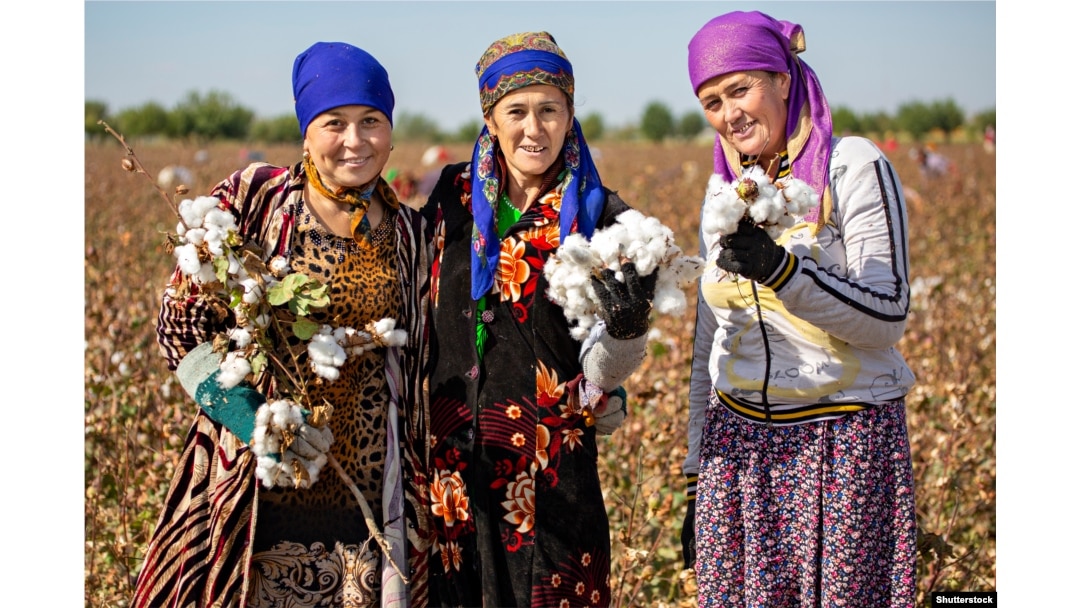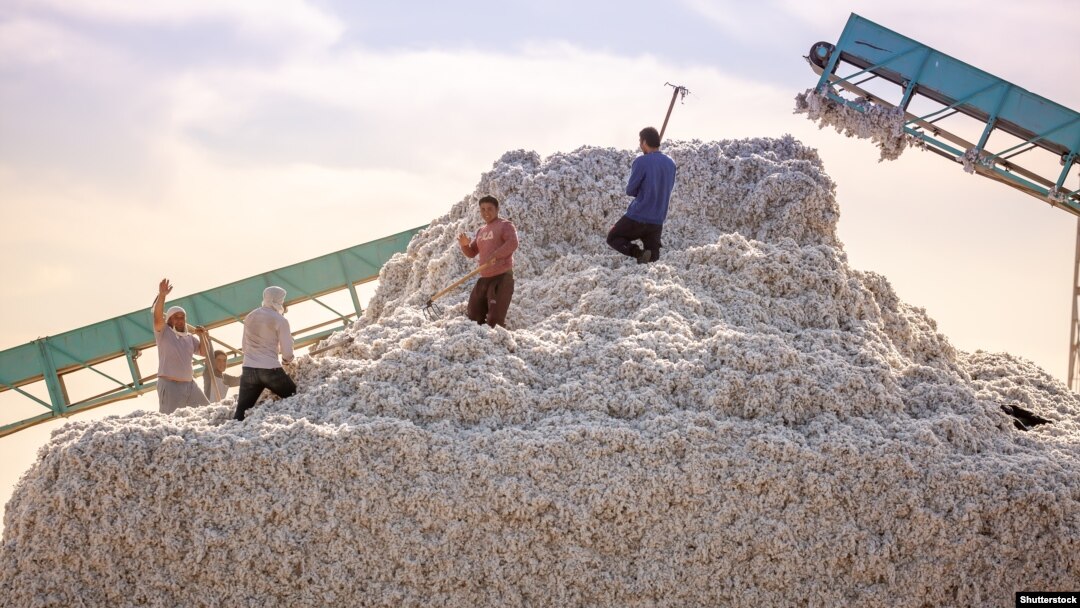ALMATY, Kazakhstan -- Cotton has had a long and tortured relationship with Central Asia, where it is associated with Russian imperial expansion, labor exploitation, and environmental disaster.
But it is also an industry that still covers swathes of the region's territory and employs millions of people each year.
And that means that low wholesale prices being offered to growers this season have been a big blow to a lot of households.
"Every morning we go to this group, hoping to see some official information about the purchase price of cotton," wrote a member of a farming-focused Telegram group consisting of more than 20,000 users in Uzbekistan, in a complaint typical of recent weeks.
"But alas, there is no encouraging news and then we walk around all day feeling depressed and we cannot plan for the future," RFE/RL's Uzbek Service quoted the user as saying.
That a single Telegram group would have so many participants points to the scale of cotton cultivation in Uzbekistan, the region's top producer and one of the world's biggest exporters.
Every year, some 2 million Uzbeks from a population of roughly 35 million are involved in the harvest, making it "the world's largest organized seasonal activity of its kind," according to the International Labor Organization (ILO).
But neighboring Turkmenistan is also around the top-10 producers globally, while cotton makes up an important part of the agricultural sectors of Kazakhstan, Kyrgyzstan, and Tajikistan, too.
But with economic and environmental pressures piling up, the industry is facing a huge battle for sustainability.
Price Takers
As the global economy eased out of coronavirus lockdowns, international prices for raw cotton enjoyed a sharp spike, more than doubling to reach around $1.50 per pound.
The correction since the middle of 2022 has been almost as severe, with the international average sinking to less than $0.80 per pound this month.

Uzbek women take part in the cotton harvest cotton on the outskirts of Samarkand in 2018.
The downturn of the last year has prompted industry analysts to muse whether cotton might be forecasting a global recession, with the price crash occurring despite high inflation and supply-chain uncertainty -- factors that would typically keep prices buoyant.
These global dynamics are not lost on farmers on the industry's front lines, who are forced to contend with prices even lower than that.
"The thing is, in many countries of the world there have been droughts and practically no cotton was grown; but in spite of this, demand for cotton is still low -- very low," said Zafar Otazhanov, a farmer in Kyrgyzstan's southern Osh Province.
The $0.73 per kilogram (1 kilogram = 2.2 pounds) offered by wholesale buyers for his crop is barely enough to cover his costs, he told RFE/RL's Kyrgyz Service.
In the adjacent province of Sughd in Tajikistan, Faizullojon Nazarov says he was unable to sell his crop at a wholesale price of more than 6.5 somonis, or $0.60 per kilogram.
That is notwithstanding rising expenses for crop input that reached around $1,300 per hectare during the last planting season.
Current prices "don't even cover labor costs, let alone leave a profit," Nazarov complained.
But suspicions remain that even in a tightening economic environment, profits are still being made further up the food chain.
Tajik girls harvest cotton in a field outside the town of Dosti in southern Tajikistan in 2006.
In the Uzbek Telegram group, some users complained about the so-called clusters -- the new privately owned, vertically integrated companies that have taken charge of a cotton harvest once micromanaged by the state.
"To whom do these artificially created clusters belong?" fumed one user in October. "Probably if we were to be paid a good price for our cotton, it is our high-ranking officials that would suffer losses."
Forced Labor: Fading Or Just Changing Shape?
Introduced in 2018, the clusters were part of a broader effort to overhaul the Uzbek cotton sector, whose reputation for forced labor and for much of independence, child labor, saw more than 300 international brands and retailers sign up to boycott Uzbek cotton.
That boycott lasted more than a decade but is no longer in force after the campaign's partner, the Berlin-based Uzbek Forum for Human Rights, said in 2021 that despite incidents of forced labor directed by officials, the practice could no longer be said to be "systemic or systematic."
It was primarily this drive to end "modern slavery" that earned Uzbekistan recognition as Country of the Year from The Economist for 2019, and brought new President Shavkat Mirziyoev plaudits at home and abroad.
But Uzbekistan's new cluster-centered system has proven both "flawed" and "abusive" for farmers, says Umida Niyazova, director of the Uzbek Forum. "Dozens of farmers [interviewed by Uzbek Forum] say that Uzbek cotton is expensive for them to produce because they are forced to use products supplied by the clusters (seeds, fertilizers, diesel) at an inflated price," she told RFE/RL.
"Another problem is the lack of freedom of farmers to decide how much cotton [or other crops] they produce on the land they lease. Some farmers say it is not even profitable for them to grow cotton, but the allocation system forces them to do so," the monitor said.
Despite the ban, child labor continues in the cotton fields of Turkmenistan.
And perhaps most crucially, farmers have few means of self-organizing against the clusters, which enjoy strong backing from the government.
Niyazova and other rights activists have documented several instances of cooperatives formed by farmers to gain autonomy from the clusters that are being shut down by the authorities. "The price of cotton is simply being dictated by the clusters, who can rely on local authorities to make sure the farmers agree," Niyazova said.
Meanwhile, Turkmenistan remains an unashamed proponent of old-school forced labor.
RFE/RL's Turkmen Service has reported regular instances of state officials being sent en masse to pick cotton in Turkmenistan during the current harvesting season, which officials recently extended to the beginning of December.
RFE/RL's Tajik Service reported that many farmers in the north of the country are effectively compelled to use at least half of the land that they rent from the state to grow the crop, although there is no legal requirement for them to do this.
Water Woes
Mass cotton growing was not just an outcome of Russian imperial expansion into Central Asia, but one of its major motivations, as nascent industrialization grew domestic Russian demand for the crop. But it wasn't until the Soviet period that countries like Uzbekistan and Turkmenistan were literally covered in cotton.
Beyond laying the foundations for labor abuses that persist to this day, the irrigation demands of the thirsty crop placed a tremendous burden on the landlocked region's water system. The most obvious victim of this process was the Aral Sea, shared by modern-day Kazakhstan and Uzbekistan.
Once the world's fourth-largest inland body of water, the Aral has lost 90 percent of its size since the 1960s, largely due to the diversion for irrigation projects of water from the two major rivers feeding the sea -- the Amu Darya and Syr Darya.
Independence brought no respite, and dust storms have become ever-more regular occurrences in the wider region surrounding the dried-up lake, sometimes ruining crops in Turkmenistan, too.
But climate change is issuing threats of its own to Central Asian farming, while another grand civil engineering project -- this time in Afghanistan -- is causing panic for governments in the region.
Experts project that water carried by the Amu Darya and Syr Darya rivers could drop by around 15 percent in the coming decades.
Abandoned fishing boats are all that remains of the Aral Sea in Kazakhstan's Kyzylorda Province in 2023.
That is without taking into account the impact of Qosh Tepa, a canal project overseen by the Taliban that will divert water from the Amu Darya for farmers in northern Afghanistan.
During a trip earlier this month to the southern Surxondaryo Province that borders Afghanistan, Uzbekistan's Mirziyoev said it was vital to "inculcate in the population the idea that water is not free" in order to conserve supplies, according to a statement from his office.
At the same time, the statement said, the authorities were working to fix chronic water wastage by replacing earthen irrigation channels that lose around 35 percent of the water that travels through them.
For many Central Asian cotton farmers, though, this summer's droughts were evidence enough of the problems that the region's main cash crop might face in the medium to long term.
"The harvest was poor. There wasn't enough water. The cotton practically dried up and didn't rise [from the ground] in a normal way," said Abduhofiz Mahmudov, a cotton farmer interviewed by RFE/RL's Tajik Service.
"We planted some corn on a part of our land that was unused. At first [the authorities] didn't allow us to plant it, but after they saw how the cotton failed to grow, they had to allow it," Mahmudov recalled.


